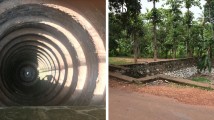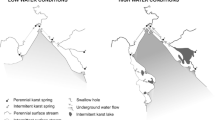Abstract
As a result of the fact that karstified rocks can accumulate large amounts of high-quality groundwater, karst aquifer is considered, throughout the world, one of the most important types of aquifers. Due to their high permeability, but also vulnerability to pollution, these precious groundwater resources need to be properly evaluated and protected. Taking into account heterogeneity and complexity of the karst environment, it is difficult to propose a uniform algorithm for managing karst groundwater, which causes the necessity to most often apply a case-by-case approach. The rules and standards of the EU Water Framework Directive require the development of Management Plans for all, and entire, river basins. Such plans include the estimation of pressures on water quality and quantity and have already been prepared for most basins of the European Union countries. This paper discusses the applied methodology and some of the results that have been obtained through the analyses of quantitative pressure on delineated groundwater bodies within the Danube and Sava River basins in Bosnia & Herzegovina and Serbia. The analyses confirmed the immense potential of karst aquifers in both countries as regards groundwater quantity.
Similar content being viewed by others
References
Agency for Sava River Basin (ASRB) (2016) Sava River Basin Management Plan in Federation of B&H, draft version, Sarajevo. https://www.voda.ba
Alley WM (2007) Another water budget myth: the significance of recoverable ground water in storage. Ground Water 45(3):251
Bakalowicz M (2010) Management of karst groundwater resources. In: van Beynen Philip E (ed) Karst management. Springer International Publishing, Cham, pp 263–282
Bonacci O (2012) 2012: Increase of mean annual surface air temperature in the western Balkans during last 30 years. Vodoprivreda 44(255–257):75–89
Bonacci O (2015) Surface waters and groundwater in karst. In: Stevanović Z (ed) Characterization and engineering of karst aquifers. Springer International Publishing, Cham, pp 149–169
Bonacci O, Andrić I (2015) Hydrological analysis of Žrnovnica karst spring near Split (in Croatian). Croat Waters 23(94):311–320
Bredehoeft JD (2002) The water budget myth revisited: why hydrogeologists model. Ground Water 40(4):340–345
Burke JJ, Moench HM (2000) Groundwater and society: resources, tensions and opportunities. Spec ed. of DESA and ISET, UN public. st/esa/265, New York, pp 170
Custodio E (1992) Hydrogeological and hydrochemical aspects of aquifer overexploitation. Selec. Pap. of IAH, vol 3. Verlag Heinz Heise, pp 3–27
Devlin JF, Sophocleous M (2005) The persistence of the water budget myth and its relationship to sustainability. Hydrogeol J 13:549–554
EC Report (2012) EC Report from the Commission to the European Parliament and the Council on the implementation of the Water Framework Directive (2000/60/EC), Brussels
Goldscheider N (2015) Overview of methods applied in karst hydrogeology. In: Stevanović Z (ed) Karst aquifers characterization and engineering. Springer International Publishing, Cham, pp 127–149
Government of Brčko Distrikt (2016) Sava river basin management plan in Brčko Distrikt, draft version, Brčko. https://www.bdcentral.net
Herak M (1972) Karst of Yugoslavia. In: Herak M, Stringfield VT (eds) Karst: important karst regions of the northern hemisphere. Elsevier Press, Amsterdam, pp 25–83
Herak M, Magdalenić A, Bahun S (1981) Karst hydrogeology. In: Halasi Kun GJ (ed) Pollution and water resources. Columbia University seminar series, part 1, Hydrogeology and other selected reports, vol XIV. Pergamon Press, New York, pp 163–178
Krešić N (2010) Sustainability and management of springs. In: Krešić N, Stevanović Z (eds) Groundwater hydrology of springs—engineering, theory, management and sustainability. Butterwoth-Heinemann, Burlington, pp 1–29
Krešić N (2013) Water in karst—management, vulnerability and restoration. McGraw Hill, New York, p 708
Meinzer OE (1920) Quantitative methods of estimating groundwater supplies. Bull Geol Soc Am 31:329–338
Poehls DJ, Smith GJ (2009) Encyclopedic dictionary of hydrogeology. Elsevier Inc., Amsterdam
Public Institute “Vode Srpske” (“Water of Srpska”) (2016) Sava river basin management plan in the Republic of Srpska, draft version, Bijeljina. https://www.voders.org
Roje-Bonacci T, Bonacci O (2013) The possible negative consequences of underground dam and reservoir construction and operation in coastal karst areas: an example of the hydro-electric power plant (HEPP) Ombla near Dubrovnik (Croatia). Nat Hazards Earth Syst Sci 13:2041–2052
Stevanović Z (1991) Hydrogeology of Carpathian-Balkan karst of eastern Serbia and water supply opportunities, (in Serbian). Faculty of Mining and Geology (spec. ed.), Belgrade, p 245
Stevanović Z (2010) Utilization and regulation of springs. In: Krešić N, Stevanović Z (eds) Groundwater hydrology of springs—engineering, theory, management and sustainability. Butterwoth-Heinemann, Burlington, pp 339–387
Stevanović Z (2011) Management of groundwater resources (in Serbian). University of Belgrade, Faculty of Mining & Geology, Belgrade, p 340
Stevanović Z (2015a) Characterization of karst aquifers. In: Stevanović Z (ed) Characterization and engineering of karst aquifers. Springer International Publishing, Cham, pp 47–122
Stevanović Z (2015b) Budget and general assessment of karst groundwater resources. In: Stevanović Z (ed) Characterization and engineering of karst aquifers. Springer International Publishing, Cham, pp 171–205
Stevanović Z (2018) Global distribution and use of water from karst aquifers. In: Parise M, Gabrovsek F, Kaufmann G, Ravbar N (eds) Advances in karst research: theory, fieldwork and applications, vol 466. Geological Society, London, Special Publications, pp 217–236
Stevanović Z, Marinović V (2016) The role and importance of hydrogeology in the creation of river basin management plans at a regional scale. In: Conference proceedings and book of abstracts / IWA specialist groundwater conference, Jaroslav Černi Institute for the Development of Water Resources, pp 180–186
Stevanović Z, Kukurić N, Pekaš Ž, Jolović B, Pambuku A, Radojević D (2016) Dinaric karst aquifer—one of the world’s largest transboundary systems and an ideal location for applying innovative and integrated water management. In: Stevanović Z, Kresic N, Kukuric N (eds) Karst without boundaries. Taylor & Francis Group, London, pp 3–25
WFD (2005) Common implementation strategy for the water framework directive (2000/60/EC) groundwater summary report. Directorate General Environment of the European Commission, Brussels
WFD CIS Guidance Document No. 15 (2007) Common implementation strategy for the water framework directive (2000/60/EC) guidance on groundwater monitoring. Directorate General Environment of the European Commission, Brussels
WFD CIS Guidance Document No. 18 (2009) Common implementation strategy for the water framework directive (2000/60/EC) guidance on groundwater status and trend assessment. Directorate General Environment of the European Commission, Brussels
Author information
Authors and Affiliations
Corresponding author
Additional information
Publisher's Note
Springer Nature remains neutral with regard to jurisdictional claims in published maps and institutional affiliations.
This article is a part of a Topical Collection in Environmental Earth Sciences on Sustainable Management of Karst Natural Resources, guest edited by Drs. Sasa Malinovic and Zoran Stevanovic.
Rights and permissions
About this article
Cite this article
Marinović, V., Stevanović, Z. Karst groundwater quantity assessment and sustainability: the approach appropriate for river basin management plans. Environ Earth Sci 78, 362 (2019). https://doi.org/10.1007/s12665-019-8364-3
Received:
Accepted:
Published:
DOI: https://doi.org/10.1007/s12665-019-8364-3











